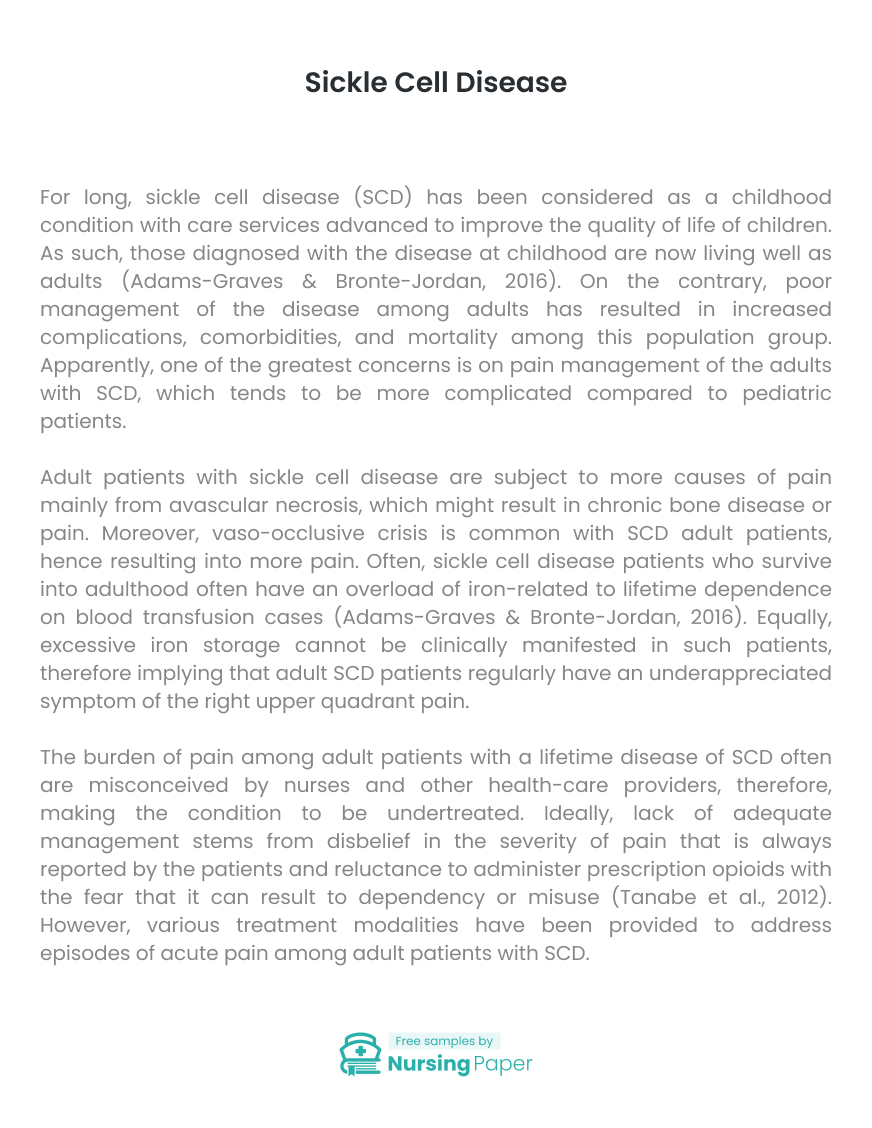
Introduction
For long, sickle cell disease (SCD) has been considered as a childhood condition with care services advanced to improve the quality of life of children. As such, those diagnosed with the disease at childhood are now living well as adults (Adams-Graves & Bronte-Jordan, 2016). On the contrary, poor management of the disease among adults has resulted in increased complications, comorbidities, and mortality among this population group. Apparently, one of the greatest concerns is on pain management of the adults with SCD, which tends to be more complicated compared to pediatric patients.
Adult patients with sickle cell disease are subject to more causes of pain mainly from avascular necrosis, which might result in chronic bone disease or pain. Moreover, vaso-occlusive crisis is common with SCD adult patients, hence resulting into more pain. Often, sickle cell disease patients who survive into adulthood often have an overload of iron-related to lifetime dependence on blood transfusion cases (Adams-Graves & Bronte-Jordan, 2016). Equally, excessive iron storage cannot be clinically manifested in such patients, therefore implying that adult SCD patients regularly have an underappreciated symptom of the right upper quadrant pain.


The burden of pain among adult patients with a lifetime disease of SCD often are misconceived by nurses and other health-care providers, therefore, making the condition to be undertreated. Ideally, lack of adequate management stems from disbelief in the severity of pain that is always reported by the patients and reluctance to administer prescription opioids with the fear that it can result to dependency or misuse (Tanabe et al., 2012). However, various treatment modalities have been provided to address episodes of acute pain among adult patients with SCD. These include the use of nonsteroidal anti-inflammatory drugs that are mainly administered to manage mild-to-moderate pain. Likewise, for SCD patients with chronic pain, parenteral opioids are recommended (Adams-Graves & Bronte-Jordan, 2016). Other aspects of considerations during pain management for the adult patients with SCD include the use of nonpharmacologic methods, hydration, and oral antihistamines to manage itching that arises from the use of prescription opioids.
As such, even though pain management modalities exist in treatment protocols, health-care providers often fail to assess pain amicably in order to choose a suitable approach for SCD patients (Tanabe et al., 2012). Besides, dose ranges and time for administering these drugs can result from inadequate assessment hence leading to poor pain management as evidenced by increased frequency to emergency department visits.
1. Adams-Graves, P., & Bronte-Jordan, L. (2016). Recent treatment guidelines for managing adult patients with sickle cell disease: challenges in access to care, social issues, and adherence. Expert review of hematology, 9(6), 541-552.
2. Tanabe, P., Hafner, J. W., Martinovich, Z., & Artz, N. (2012). Adult emergency department patients with sickle cell pain crisis: results from a quality improvement learning collaborative model to improve analgesic management. Academic Emergency Medicine, 19(4), 430-438.



The download will start shortly.

The download will start shortly.
 Subject:
Medicine
Subject:
Medicine  Number of pages: 2
Number of pages: 2  Subject:
Nursing
Subject:
Nursing  Number of pages: 2
Number of pages: 2  Subject:
Health and Social Care
Subject:
Health and Social Care  Number of pages: 3
Number of pages: 3  Subject:
Medicine
Subject:
Medicine  Number of pages: 3
Number of pages: 3  Subject:
Health and Social Care
Subject:
Health and Social Care  Number of pages: 4
Number of pages: 4  Subject:
Nursing
Subject:
Nursing  Number of pages: 4
Number of pages: 4  Subject:
Health and Social Care
Subject:
Health and Social Care  Number of pages: 5
Number of pages: 5  Subject:
Nursing
Subject:
Nursing  Number of pages: 2
Number of pages: 2  Subject:
Health and Social Care
Subject:
Health and Social Care  Number of pages: 3
Number of pages: 3  Subject:
Nursing
Subject:
Nursing  Number of pages: 8
Number of pages: 8  Subject:
Nursing
Subject:
Nursing  Number of pages: 4
Number of pages: 4  Subject:
Health and Social Care
Subject:
Health and Social Care  Number of pages: 3
Number of pages: 3  Subject:
Nursing
Subject:
Nursing  Number of pages: 3
Number of pages: 3  Subject:
Nursing
Subject:
Nursing  Number of pages: 7
Number of pages: 7  Subject:
Health and Social Care
Subject:
Health and Social Care  Number of pages: 8
Number of pages: 8 
